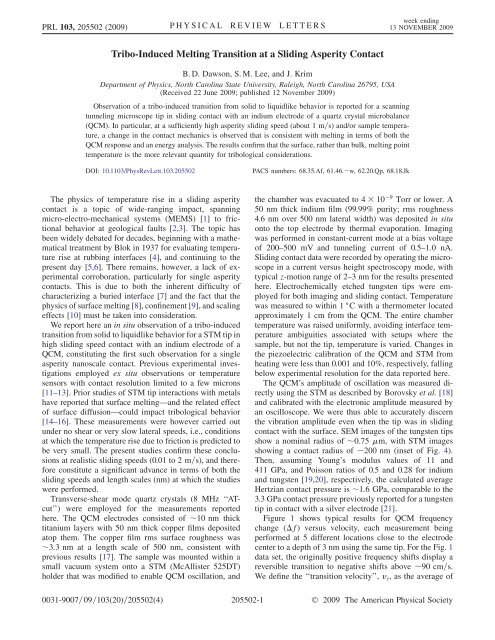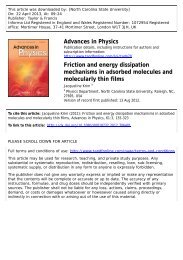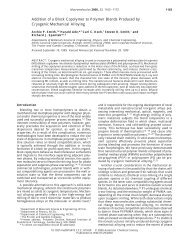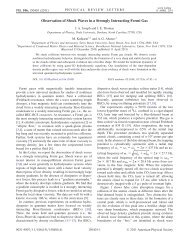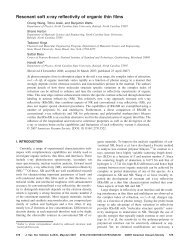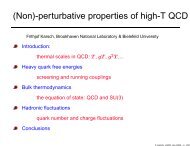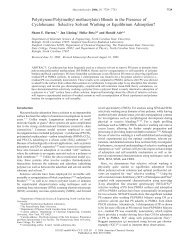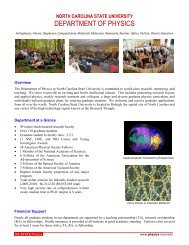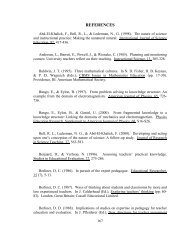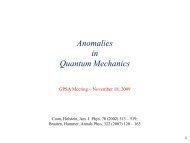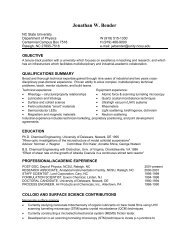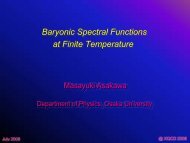Tribo-Induced Melting Transition at a Sliding Asperity Contact
Tribo-Induced Melting Transition at a Sliding Asperity Contact
Tribo-Induced Melting Transition at a Sliding Asperity Contact
You also want an ePaper? Increase the reach of your titles
YUMPU automatically turns print PDFs into web optimized ePapers that Google loves.
PRL 103, 205502 (2009) PHYSICAL REVIEW LETTERS<br />
week ending<br />
13 NOVEMBER 2009<br />
<strong>Tribo</strong>-<strong>Induced</strong> <strong>Melting</strong> <strong>Transition</strong> <strong>at</strong> a <strong>Sliding</strong> <strong>Asperity</strong> <strong>Contact</strong><br />
B. D. Dawson, S. M. Lee, and J. Krim<br />
Department of Physics, North Carolina St<strong>at</strong>e University, Raleigh, North Carolina 26795, USA<br />
(Received 22 June 2009; published 12 November 2009)<br />
Observ<strong>at</strong>ion of a tribo-induced transition from solid to liquidlike behavior is reported for a scanning<br />
tunneling microscope tip in sliding contact with an indium electrode of a quartz crystal microbalance<br />
(QCM). In particular, <strong>at</strong> a sufficiently high asperity sliding speed (about 1m=s) and/or sample temper<strong>at</strong>ure,<br />
a change in the contact mechanics is observed th<strong>at</strong> is consistent with melting in terms of both the<br />
QCM response and an energy analysis. The results confirm th<strong>at</strong> the surface, r<strong>at</strong>her than bulk, melting point<br />
temper<strong>at</strong>ure is the more relevant quantity for tribological consider<strong>at</strong>ions.<br />
DOI: 10.1103/PhysRevLett.103.205502 PACS numbers: 68.35.Af, 61.46. w, 62.20.Qp, 68.18.Jk<br />
The physics of temper<strong>at</strong>ure rise in a sliding asperity<br />
contact is a topic of wide-ranging impact, spanning<br />
micro-electro-mechanical systems (MEMS) [1] to frictional<br />
behavior <strong>at</strong> geological faults [2,3]. The topic has<br />
been widely deb<strong>at</strong>ed for decades, beginning with a m<strong>at</strong>hem<strong>at</strong>ical<br />
tre<strong>at</strong>ment by Blok in 1937 for evalu<strong>at</strong>ing temper<strong>at</strong>ure<br />
rise <strong>at</strong> rubbing interfaces [4], and continuing to the<br />
present day [5,6]. There remains, however, a lack of experimental<br />
corrobor<strong>at</strong>ion, particularly for single asperity<br />
contacts. This is due to both the inherent difficulty of<br />
characterizing a buried interface [7] and the fact th<strong>at</strong> the<br />
physics of surface melting [8], confinement [9], and scaling<br />
effects [10] must be taken into consider<strong>at</strong>ion.<br />
We report here an in situ observ<strong>at</strong>ion of a tribo-induced<br />
transition from solid to liquidlike behavior for a STM tip in<br />
high sliding speed contact with an indium electrode of a<br />
QCM, constituting the first such observ<strong>at</strong>ion for a single<br />
asperity nanoscale contact. Previous experimental investig<strong>at</strong>ions<br />
employed ex situ observ<strong>at</strong>ions or temper<strong>at</strong>ure<br />
sensors with contact resolution limited to a few microns<br />
[11–13]. Prior studies of STM tip interactions with metals<br />
have reported th<strong>at</strong> surface melting—and the rel<strong>at</strong>ed effect<br />
of surface diffusion—could impact tribological behavior<br />
[14–16]. These measurements were however carried out<br />
under no shear or very slow l<strong>at</strong>eral speeds, i.e., conditions<br />
<strong>at</strong> which the temper<strong>at</strong>ure rise due to friction is predicted to<br />
be very small. The present studies confirm these conclusions<br />
<strong>at</strong> realistic sliding speeds (0.01 to 2m=s), and therefore<br />
constitute a significant advance in terms of both the<br />
sliding speeds and length scales (nm) <strong>at</strong> which the studies<br />
were performed.<br />
Transverse-shear mode quartz crystals (8 MHz ‘‘ATcut’’)<br />
were employed for the measurements reported<br />
here. The QCM electrodes consisted of 10 nm thick<br />
titanium layers with 50 nm thick copper films deposited<br />
<strong>at</strong>op them. The copper film rms surface roughness was<br />
3:3 nm <strong>at</strong> a length scale of 500 nm, consistent with<br />
previous results [17]. The sample was mounted within a<br />
small vacuum system onto a STM (McAllister 525DT)<br />
holder th<strong>at</strong> was modified to enable QCM oscill<strong>at</strong>ion, and<br />
the chamber was evacu<strong>at</strong>ed to 4 10 9 Torr or lower. A<br />
50 nm thick indium film (99.99% purity; rms roughness<br />
4.6 nm over 500 nm l<strong>at</strong>eral width) was deposited in situ<br />
onto the top electrode by thermal evapor<strong>at</strong>ion. Imaging<br />
was performed in constant-current mode <strong>at</strong> a bias voltage<br />
of 200–500 mV and tunneling current of 0.5–1.0 nA.<br />
<strong>Sliding</strong> contact d<strong>at</strong>a were recorded by oper<strong>at</strong>ing the microscope<br />
in a current versus height spectroscopy mode, with<br />
typical z-motion range of 2–3 nm for the results presented<br />
here. Electrochemically etched tungsten tips were employed<br />
for both imaging and sliding contact. Temper<strong>at</strong>ure<br />
was measured to within 1 C with a thermometer loc<strong>at</strong>ed<br />
approxim<strong>at</strong>ely 1 cm from the QCM. The entire chamber<br />
temper<strong>at</strong>ure was raised uniformly, avoiding interface temper<strong>at</strong>ure<br />
ambiguities associ<strong>at</strong>ed with setups where the<br />
sample, but not the tip, temper<strong>at</strong>ure is varied. Changes in<br />
the piezoelectric calibr<strong>at</strong>ion of the QCM and STM from<br />
he<strong>at</strong>ing were less than 0.001 and 10%, respectively, falling<br />
below experimental resolution for the d<strong>at</strong>a reported here.<br />
The QCM’s amplitude of oscill<strong>at</strong>ion was measured directly<br />
using the STM as described by Borovsky et al. [18]<br />
and calibr<strong>at</strong>ed with the electronic amplitude measured by<br />
an oscilloscope. We were thus able to accur<strong>at</strong>ely discern<br />
the vibr<strong>at</strong>ion amplitude even when the tip was in sliding<br />
contact with the surface. SEM images of the tungsten tips<br />
show a nominal radius of 0:75 m, with STM images<br />
showing a contact radius of 200 nm (inset of Fig. 4).<br />
Then, assuming Young’s modulus values of 11 and<br />
411 GPa, and Poisson r<strong>at</strong>ios of 0.5 and 0.28 for indium<br />
and tungsten [19,20], respectively, the calcul<strong>at</strong>ed average<br />
Hertzian contact pressure is 1:6 GPa, comparable to the<br />
3.3 GPa contact pressure previously reported for a tungsten<br />
tip in contact with a silver electrode [21].<br />
Figure 1 shows typical results for QCM frequency<br />
change (f) versus velocity, each measurement being<br />
performed <strong>at</strong> 5 different loc<strong>at</strong>ions close to the electrode<br />
center to a depth of 3 nm using the same tip. For the Fig. 1<br />
d<strong>at</strong>a set, the originally positive frequency shifts display a<br />
reversible transition to neg<strong>at</strong>ive shifts above 90 cm=s.<br />
We define the ‘‘transition velocity’’, v t , as the average of<br />
0031-9007=09=103(20)=205502(4) 205502-1 Ó 2009 The American Physical Society
PRL 103, 205502 (2009) PHYSICAL REVIEW LETTERS<br />
week ending<br />
13 NOVEMBER 2009<br />
FIG. 1 (color online). Frequency shifts as a function of electrode<br />
velocity amplitude, exhibiting a dependence on velocity for<br />
the sign of the frequency shift. Inset: Change in amplitude for<br />
electrode velocity amplitudes of, from smallest amplitude<br />
change to largest, 9, 72, 106, and 162 cm=s.<br />
the fastest positive frequency shift velocity with the slowest<br />
neg<strong>at</strong>ive shift velocity. The inset of Fig. 1 shows typical<br />
changes in amplitude. The transition velocity is expected to<br />
depend on contact area, tip sharpness, film thickness, surface<br />
contamin<strong>at</strong>ion (or lubric<strong>at</strong>ion), and temper<strong>at</strong>ure.<br />
However, a velocity dependent melting transition should<br />
always extrapol<strong>at</strong>e to the melting temper<strong>at</strong>ure <strong>at</strong> v t ¼ 0<br />
irrespective of the tip-sample combin<strong>at</strong>ion. We therefore<br />
performed the measurements with tips of varying contact<br />
radii, and, as expected for melting, the transition velocities<br />
for all d<strong>at</strong>a sets dropped with increasing temper<strong>at</strong>ure and<br />
extrapol<strong>at</strong>ed in all cases to 114 9 C.<br />
The observed transition is reversible and thus cannot be<br />
associ<strong>at</strong>ed with irreversible tip blunting or chemical reaction<br />
phenomena. To demonstr<strong>at</strong>e this, Fig. 2 displays typical<br />
frequency shift d<strong>at</strong>a for a tip (not the same as th<strong>at</strong><br />
employed in Fig. 1) th<strong>at</strong> is in contact with the electrode<br />
as the velocity is increased and decreased. The first part of<br />
Fig. 2 shows an indent<strong>at</strong>ion in which the substr<strong>at</strong>e speed<br />
was initially below the transition velocity, eliciting an<br />
initial positive f from the crystal. The speed was then<br />
increased and f became neg<strong>at</strong>ive until the tip was retracted<br />
from the surface. Reverse behavior is observed<br />
when the procedure is performed in the reverse order.<br />
Figure 3 presents represent<strong>at</strong>ive d<strong>at</strong>a sets for the dependence<br />
of the transition velocity on system temper<strong>at</strong>ure. The<br />
difference in transition velocities between the runs can<br />
again be <strong>at</strong>tributed to different tip morphologies [21],<br />
confirmed by the difference in the magnitude of f between<br />
the runs. Run 1 had a f approxim<strong>at</strong>ely 5 times<br />
p<br />
larger than run 2, corresponding to a contact radius ffiffiffi<br />
5<br />
larger [21]. By varying the tip morphology, the temper<strong>at</strong>ure<br />
runs confirm th<strong>at</strong> the transition is consistent with melting<br />
FIG. 2 (color online). Frequency shift versus time as the<br />
electrode velocity amplitude is varied. This documents the<br />
reversible n<strong>at</strong>ure of the transition. (see text).<br />
since these, and all other d<strong>at</strong>a sets, converge <strong>at</strong> higher<br />
temper<strong>at</strong>ures and extrapol<strong>at</strong>e in all cases to 114 9 C.<br />
This implies th<strong>at</strong> a liquid is present with no frictional<br />
energy supplied <strong>at</strong> this temper<strong>at</strong>ure. These values agree<br />
well with the reported values for surface melting of indium<br />
[In(110) and In(011) reported as 129 C and 110 C, respectively<br />
[8]]; thus, we conclude th<strong>at</strong> the onset of the<br />
observed liquidlike response of the QCM is due to surface<br />
melting of the substr<strong>at</strong>e from tribological energy dissip<strong>at</strong>ion.<br />
We <strong>at</strong>tribute the frequency shift sign reversal to the<br />
onset of a finite surface melted layer present on the QCM.<br />
This type of transition would be reversible, and would<br />
reduce the stiffness of an originally solid contact, thus<br />
FIG. 3 (color online). <strong>Transition</strong> velocity vs sample temper<strong>at</strong>ure.<br />
The lines extrapol<strong>at</strong>e to 114 9 C for v t ¼ 0, which<br />
m<strong>at</strong>ches the surface melting temper<strong>at</strong>ures of indium.<br />
205502-2
PRL 103, 205502 (2009) PHYSICAL REVIEW LETTERS<br />
week ending<br />
13 NOVEMBER 2009<br />
giving rise to a neg<strong>at</strong>ive frequency shift r<strong>at</strong>her than the<br />
anticip<strong>at</strong>ed positive frequency shift [21,22].<br />
We observed the velocity dependent frequency shifts<br />
presented in Figs. 1–3 repe<strong>at</strong>edly and for a variety of<br />
tips. Although we expect various local factors to influence<br />
the exact velocity <strong>at</strong> which the transition occurs, we find<br />
th<strong>at</strong> (i) the transition is always observed as the temper<strong>at</strong>ure<br />
of the system is raised towards the surface melting point<br />
temper<strong>at</strong>ure of indium, (ii) is always observed to be below<br />
the melting point temper<strong>at</strong>ure of indium (156:6 C), and<br />
(iii) is completely reversible. We now discuss this, and<br />
other potential mechanisms for the experimentally observed<br />
behaviors, and conclude th<strong>at</strong> melting is the most<br />
likely, if not the only, viable explan<strong>at</strong>ion of the observed<br />
transition.<br />
(i) The tip goes from sticking to sliding.—Borovsky et al.<br />
[23] have recently shown th<strong>at</strong> under normal oper<strong>at</strong>ing<br />
conditions, full slip is readily <strong>at</strong>tainable for an indenter<br />
probe in contact with an oscill<strong>at</strong>ing QCM. In their results, a<br />
positive frequency shift was always reported, whether they<br />
had full slip or stuck conditions, and in all cases they found<br />
a nonzero bandwidth shift indic<strong>at</strong>ing some form of tribological<br />
energy dissip<strong>at</strong>ion. We assert th<strong>at</strong> even if the tip<br />
goes from being stuck to sliding, there is some frictional<br />
dissip<strong>at</strong>ion mechanism still involved during the stuck portion,<br />
and the difference in the sign of the frequency shift is<br />
not accounted for by a transition of this type.<br />
(ii) The tip becomes blunter and/or there are irreversible<br />
effects occurring with increased amplitude (chemical,<br />
plastic deform<strong>at</strong>ion, etc).—According to theoretical models<br />
for a probe-QCM setup, positive frequency shifts are<br />
expected as long as the area of contact is smaller than the<br />
acoustic wavelength of the probe-substr<strong>at</strong>e system [21,24].<br />
From STM images the radius of the worn region is<br />
200 nm (inset of Fig. 4), while for both indium and<br />
tungsten the wavelength of 8 MHz acoustic waves is on<br />
FIG. 4. Calcul<strong>at</strong>ed steady st<strong>at</strong>e temper<strong>at</strong>ure rise. The calcul<strong>at</strong>ed<br />
dissip<strong>at</strong>ed power is: (1) 2.4, (2) 80, (3) 145, and (4) 478<br />
mW. Inset: Line profile of the indent<strong>at</strong>ion after the tip comes into<br />
contact with the surface.<br />
the order of hundreds of microns [20], with the ‘‘real’’ area<br />
of contact expected to be much less [21]. Thus, there is <strong>at</strong><br />
least 3 orders of magnitude difference between the contact<br />
radius and the acoustic wavelengths, and the models<br />
should hold for our experimental system. Also, the repe<strong>at</strong>able<br />
n<strong>at</strong>ure of the experiment rules out the possibility th<strong>at</strong><br />
tip blunting is the sole reason for the velocity dependent<br />
sign of f.<br />
(iii) The transition is rel<strong>at</strong>ed to enhanced diffusion<br />
r<strong>at</strong>her than melting.—Upon tip retraction the tip in some<br />
cases remains vertically stuck <strong>at</strong> light pull-off forces—in<br />
which case the tip is unstuck by using the coarse retract<br />
controls of the STM. This can be <strong>at</strong>tributed to form<strong>at</strong>ion of<br />
a ‘‘neck’’, such as th<strong>at</strong> reported in [14,16], due to enhanced<br />
diffusion effects. The sign of f does not depend, however,<br />
on whether the tip becomes stuck upon retraction or<br />
not, and the velocities reported here are <strong>at</strong> least 6 orders of<br />
magnitude larger than previously reported metal tipsubstr<strong>at</strong>e<br />
experiments [14–16]. Also, our applied contact<br />
pressure, nominally 1.6 GPa, cre<strong>at</strong>es a confined geometry<br />
th<strong>at</strong> fundamentally differs from the ‘‘necking’’ results of<br />
[14,16], illustr<strong>at</strong>ed by a recent AFM study demonstr<strong>at</strong>ing<br />
solidlike behavior for confined w<strong>at</strong>er <strong>at</strong> room temper<strong>at</strong>ure<br />
[9]. Another consider<strong>at</strong>ion is the ‘‘windshield wiper effect’’<br />
documented by Abdelmaksoud et al. [25], whereby<br />
mobile adlayers with liquidlike diffusivities were brushed<br />
aside by the STM tip, leaving the QCM contact bare. These<br />
consider<strong>at</strong>ions strongly suggest th<strong>at</strong> a critical thickness of<br />
liquid needs to be present for the observed transition to<br />
occur.<br />
(iv) The he<strong>at</strong> gener<strong>at</strong>ed via friction melts the indium.—<br />
Generally speaking, when a finite liquid [26], viscoelastic<br />
[27], or solid contact [21] is made with a QCM, either a<br />
neg<strong>at</strong>ive or positive frequency shift is observed, with the<br />
magnitude of the frequency shift proportional to the area of<br />
contact. In these cases, the sign of the frequency shift has<br />
remained positive for solid contacts and neg<strong>at</strong>ive for viscoelastic<br />
or liquid contacts. Additionally, reports of initially<br />
neg<strong>at</strong>ive frequency shifts becoming positive over<br />
time for cells deposited on a QCM have been <strong>at</strong>tributed<br />
to the stiffening of the adsorbed cells [28]. The velocity<br />
dependent frequency shift reversal we observe is consistent<br />
with these observ<strong>at</strong>ions; i.e., a transition from a solid (stiff)<br />
contact to a liquid contact occurs due to frictional energy<br />
dissip<strong>at</strong>ion. These frequency responses can be interpreted<br />
by <strong>at</strong>tributing positive frequency shifts to an added stiffness<br />
in the reson<strong>at</strong>or from the elastic restoring forces of the<br />
contact, with neg<strong>at</strong>ive frequency shifts <strong>at</strong>tributed to a liquid<br />
contact damping the reson<strong>at</strong>or. To the authors’ knowledge,<br />
the observ<strong>at</strong>ion of a velocity dependent frequency shift<br />
reversal has not been previously reported.<br />
To estim<strong>at</strong>e whether the he<strong>at</strong> gener<strong>at</strong>ed <strong>at</strong> an interface is<br />
sufficient to melt the substr<strong>at</strong>e, we look <strong>at</strong> the steady st<strong>at</strong>e<br />
solution to the he<strong>at</strong> equ<strong>at</strong>ion for a he<strong>at</strong> source of he<strong>at</strong> flux q<br />
contacting a semi-infinite body over an area of radius a,<br />
with the result [29]:<br />
205502-3
PRL 103, 205502 (2009) PHYSICAL REVIEW LETTERS<br />
week ending<br />
13 NOVEMBER 2009<br />
T ¼ qa k ; (1)<br />
where k ¼ 81:6 W=ðm KÞ is the thermal conductivity of<br />
indium.<br />
To calcul<strong>at</strong>e the he<strong>at</strong> flux supplied to the interface, we<br />
approxim<strong>at</strong>e the energy dissip<strong>at</strong>ion when the tip comes<br />
into contact with the QCM. We calcul<strong>at</strong>e the kinetic energy<br />
of the quartz/electrode system using the measured oscill<strong>at</strong>ion<br />
amplitude with a previously measured QCM amplitude<br />
distribution [30]. The dominant term of the kinetic<br />
energy (by 3 orders of magnitude) comes from the quartz<br />
crystal itself, taking the form:<br />
KE quartz ¼ 2R2 d½A$ cosð$tÞŠ 2 ð1 e 2b Þ<br />
; (2)<br />
16b<br />
with R the electrode radius, d the thickness of the crystal,<br />
(half of a wavelength when oper<strong>at</strong>ed in the fundamental<br />
mode), the density of quartz, ! the angular frequency, A 0<br />
the maximum amplitude of oscill<strong>at</strong>ion <strong>at</strong> the center of the<br />
electrode, t time, and b a constant of the amplitude distribution<br />
which we assume to be 3 [30]. Using the changes in<br />
amplitude from Fig. 1, we can find the change in energy per<br />
cycle, which when multiplied by the frequency yields the<br />
power dissip<strong>at</strong>ed. Figure 4 shows the results of these<br />
calcul<strong>at</strong>ions along with the calcul<strong>at</strong>ed maximum temper<strong>at</strong>ure<br />
rise assuming th<strong>at</strong> half of the dissip<strong>at</strong>ed power went<br />
into the indium as he<strong>at</strong> flux (with the other half going into<br />
the tungsten tip) <strong>at</strong> a contact radius of 200 nm. The results<br />
show th<strong>at</strong> ample energy dissip<strong>at</strong>ion is present to melt the<br />
indium.<br />
We have reported here our observ<strong>at</strong>ion of a velocity<br />
dependent transition from solid to liquidlike behavior for<br />
an STM tip in sliding contact with an indium electrode of a<br />
QCM, the first such observ<strong>at</strong>ion for a sliding asperity<br />
contact. The velocity dependent n<strong>at</strong>ure of the frequency<br />
shift implies a change in the mechanisms of frictional<br />
dissip<strong>at</strong>ion; e.g., the contact region changes from solid to<br />
liquid. An analysis of the change in kinetic energy of the<br />
QCM when the tip comes in contact with the substr<strong>at</strong>e<br />
shows th<strong>at</strong> ample energy is dissip<strong>at</strong>ed to melt the indium,<br />
with temper<strong>at</strong>ure studies indic<strong>at</strong>ing th<strong>at</strong> the onset of this<br />
transition is close to indium’s surface melting temper<strong>at</strong>ure.<br />
The results suggest th<strong>at</strong> the surface, r<strong>at</strong>her than bulk,<br />
melting point temper<strong>at</strong>ure is the more relevant quantity<br />
for tribological consider<strong>at</strong>ions.<br />
This work has been supported by the Extreme Friction<br />
MURI program, AFOSR No. FA9550-04-1-0381, and by<br />
NSF DMR0320743 and DMR0805204. D. B. Brenner and<br />
D. Irving are gr<strong>at</strong>efully acknowledged for many useful<br />
discussions.<br />
[1] S. T. P<strong>at</strong>ton et al., Nanotechnology 19, 405705 (2008).<br />
[2] G. Di Toro, T. Hirose, G. Pennacchioni, and<br />
T. Shimamoto, Science 311, 647 (2006).<br />
[3] N. M. Beeler, T. E. Tullis, and D. L. Goldsby, J. Geophys.<br />
Res. [Solid Earth] 113, B01401 (2008).<br />
[4] H. Blok, Proc. Inst. Mech. Eng. 2, 222 (1937).<br />
[5] T. Zykova-Timan, D. Ceresoli, and E. Tos<strong>at</strong>ti, N<strong>at</strong>ure<br />
M<strong>at</strong>er. 6, 230 (2007).<br />
[6] B. Vick, M. J. Furey, and K. Iskandar, <strong>Tribo</strong>l. Int. 33, 265<br />
(2000).<br />
[7] J. Krim, Am. J. Phys. 70, 890 (2002), and Refs. [95]–[102]<br />
therein.<br />
[8] A. M. Molenbroek, G. ter Horst, and J. W. M. Frenken,<br />
Surf. Sci. 365, 103 (1996).<br />
[9] K. B. Jinesh and J. W. M. Frenken, Phys. Rev. Lett. 101,<br />
036101 (2008).<br />
[10] F. Baletto and R. Ferrando, Rev. Mod. Phys. 77, 371<br />
(2005).<br />
[11] H. S. Nagaraj, D. M. Sanborn, and W. O. Winer, Wear 49,<br />
43 (1978).<br />
[12] S. C. Lim and M. F. Ashby, Acta Metall. 35, 1 (1987).<br />
[13] S. Bair, I. Green, and B. Bhushan, J. <strong>Tribo</strong>l. 113, 547<br />
(1991).<br />
[14] L. Kuipers, M. S. Hoogeman, and J. W. M. Frenken, Surf.<br />
Sci. 340, 231 (1995).<br />
[15] D. J. Bottomley, M. Iwami, Y. Uehara, and S. Ushioda,<br />
J. Vac. Sci. Technol. B 17, 12 (1999).<br />
[16] A. P. Merkle and L. D. Marks, Wear 265, 1864 (2008).<br />
[17] S. M. Lee and J. Krim, Thin Solid Films 489, 325 (2005).<br />
[18] B. Borovsky, B. L. Mason, and J. Krim, J. Appl. Phys. 88,<br />
4017 (2000).<br />
[19] D. J. Gunton and G. A. Saunders, Proc. R. Soc. A 343, 63<br />
(1975).<br />
[20] Handbook of the Physicochemical Properties of the<br />
Elements, edited by G. V. Samsonov (I F I/Plenum D<strong>at</strong>a<br />
Corpor<strong>at</strong>ion, New York, 1968).<br />
[21] B. Borovsky, J. Krim, S. A. Syed Asif, and K. J. Wahl,<br />
J. Appl. Phys. 90, 6391 (2001).<br />
[22] B. Du, A. M. King, and D. Johannsmann, New J. Phys. 10,<br />
053014 (2008).<br />
[23] B. Borovsky, A. Booth, and E. Manlove, Appl. Phys. Lett.<br />
91, 114101 (2007).<br />
[24] A. Laschitsch and D. Johannsmann, J. Appl. Phys. 85,<br />
3759 (1999).<br />
[25] M. Abdelmaksoud et al., Langmuir 22, 9606 (2006).<br />
[26] M. Herrscher, C. Ziegler, and D. Johannsmann, J. Appl.<br />
Phys. 101, 114909 (2007).<br />
[27] C. M. Flanigan, M. Desai, and K. R. Shull, Langmuir 16,<br />
9825 (2000).<br />
[28] A. Alessandrini, M. A. Croce, R. Tiozzo, and P. Facci,<br />
Appl. Phys. Lett. 88, 083905 (2006).<br />
[29] B. Bhushan, ed., Modern <strong>Tribo</strong>logy Handbook (CRC<br />
Press, Boca R<strong>at</strong>on, 2001), Vol. 1.<br />
[30] B. A. Martin and H. A. Hager, J. Appl. Phys. 65, 2630<br />
(1989).<br />
205502-4


